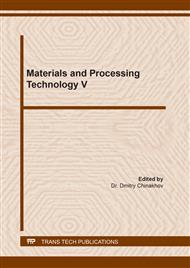[1]
Polema. Joint Stock Company [Electronic resource]. 2021. URL: http://www.polema.net (access date: 23.04.2021).
Google Scholar
[2]
K. Zhuravleva, S. Scudino, M.S. Khoshkhoo, A. Gebert, M. Calin, L. Schultz, J. Eckert, Mechanical Alloying of β‐Type Ti-Nb for Biomedical Applications, Adv. Eng. Mater. 15, 4 (2013) 262-266.
DOI: 10.1002/adem.201200117
Google Scholar
[3]
Zh.G. Kovalevskaya, Yu.P. Sharkeev, M.A. Khimich, M.A. Korchagin, V.A. Bataev, Ti-Nb Powder Alloys in the Additive Technologies, Nanosci. Technol.: An Int. J. 8(3) (2017) 203-210.
DOI: 10.1615/nanoscitechnolintj.v8.i3.30
Google Scholar
[4]
M.A. Surmeneva, A. Koptyug, D. Khrapov, Yu.F. Ivanov, T. Mishurova, S. Evsevleev, O. Prymak, K. Loza, M. Epple, G. Bruno, R.A. Surmenev, In situ synthesis of a binary Ti–10at% Nb alloy by electron beam melting using a mixture of elemental niobium and titanium powders, J. Mater. Process. Technol. 282 (2020) 116646. Doi: https://doi.org/10.1016/j.jmatprotec.2020.116646.
DOI: 10.1016/j.jmatprotec.2020.116646
Google Scholar
[5]
M.A. Khimich, E.A. Ibragimov, N.A. Saprykina, Yu.P. Sharkeev, A.A. Saprykin, Co-Cr-Mo alloy produced via powder bed laser fusion, AIP Conference Proceedings. 2310 (2020) 020144. Doi: https://doi.org/10.1063/5.0034111.
DOI: 10.1063/5.0034111
Google Scholar
[6]
D. Wei, Y. Koizumi, A. Chiba, K. Ueki, K. Ueda, T. Narushima, Y. Tsutsumi, T. Hanawa, Heterogeneous microstructures and corrosion resistance of biomedical Co-Cr-Mo alloy fabricated by electron beam melting (EBM), Additive Manuf. 24 (2018) 103-114.
DOI: 10.1016/j.addma.2018.09.006
Google Scholar
[7]
M.A. Khimich, K.A. Prosolov, T. Mishurova, S. Evsevleev, X. Monforte, A.H. Teuschl, P. Slezak, E.A. Ibragimov, A.A. Saprykin, Z.G. Kovalevskaya, A.I. Dmitriev, G. Bruno, Y.P. Sharkeev, Advances in Laser Additive Manufacturing of Ti-Nb Alloys: From Nanostructured Powders to Bulk Objects, Nanomater. 11 (2021) 1159. Doi: https://doi.org/10.3390/nano11051159.
DOI: 10.3390/nano11051159
Google Scholar
[8]
A. J. Saldı´var-Garcıa, H. F. Lo´pez, Microstructural effects on the wear resistance of wrought and as-cast Co-Cr-Mo-C implant alloys, J. Biomed. Mater. Res. 74A(2) (2005) 269-274.
DOI: 10.1002/jbm.a.30392
Google Scholar
[9]
Y. Chen, Y. Li, S. Kurosu, K. Yamanaka, N. Tang, A. Chiba, Effects of microstructures on the sliding behavior of hot-pressed CoCrMo alloys, Wear 319 (2014) 200–21.
DOI: 10.1016/j.wear.2014.07.022
Google Scholar
[10]
Z. Guoqing, Y. Yongqiang, L. Hui, S. Changhui, Z. Zimian, Study on the Quality and Performance of CoCrMo Alloy Parts Manufactured by Selective Laser Melting, JMEPEG 26 (2017) 2869–2877.
DOI: 10.1007/s11665-017-2716-5
Google Scholar
[11]
F.Z. Hassani, M. Ketabchi, S. Bruschi, A. Ghiotti, Effects of carbide precipitation on the microstructural and tribological properties of Co–Cr–Mo–C medical implants after thermal treatment, J Mater Sci 51 (2016) 4495–4508.
DOI: 10.1007/s10853-016-9762-5
Google Scholar
[12]
R. Liu, J. Yao, Q. Zhang, M.X. Yao, R. Collier, Effects of molybdenum content on the wear/erosion and corrosion performance of low-carbon Stellite alloys, Mater. & Design 78 (2015) 95–106. Doi: http://dx.doi.org/10.1016/j.matdes.2015.04.030.
DOI: 10.1016/j.matdes.2015.04.030
Google Scholar
[13]
M. Mori, K. Yamanaka, A. Chiba, Phase decomposition in biomedical Co–29Cr–6Mo–0.2N alloy during isothermal heat treatment at 1073 K, J. Alloys and Compounds 590 (2014) 411–416. Doi: http://dx.doi.org/10.1016/j.jallcom.2013.12.126.
DOI: 10.1016/j.jallcom.2013.12.126
Google Scholar
[14]
Zh.G. Kovalevskaya, M.A. Khimich, A.V. Belyakov, Evaluation of physical-mechanical properties of Ti-45Nb specimens obtained by selective laser melting, KEM. 743 (2017) 9-12.
DOI: 10.4028/www.scientific.net/kem.743.9
Google Scholar
[15]
M.A. Khimich, E.A. Ibragimov, V.I. Yakovlev, A.I. Tolmachev, V.V. Chebodaeva, P.V. Uvarkin, N.A. Saprykina, A.A. Saprykin, Yu.P. Sharkeev, Structure and Phase Composition of Additive Co-Cr-Mo Alloy Affected by the Duration of Mechanical Alloying the Composite Powder, AIP Conference Proceedings. (2021). In press.
DOI: 10.1063/5.0084867
Google Scholar
[16]
M. Zhang, Y. Yang, C. Song, Y. Bai, Z. Xiao, An investigation into the aging behavior of CoCrMo alloys fabricated by selective laser melting, J. Alloys and Compounds. 750 (2018) 878-886. Doi: https://doi.org/10.1016/j.jallcom.2018.04.054.
DOI: 10.1016/j.jallcom.2018.04.054
Google Scholar
[17]
M. Mori, K. Yamanaka, S. Sato, S. Tsubaki, K. Satoh, M. Kumagai, M. Imafuku, T. Shobu, A. Chiba, Tuning strain-induced γ-to-ε martensitic transformation of biomedical Co-Cr-Mo alloys by introducing parent phase lattice defects, J. Mech. Behav. Biomed. Mater. 90 (2019) 523–529. Doi: https://doi.org/10.1016/j.jmbbm.2018.10.038.
DOI: 10.1016/j.jmbbm.2018.10.038
Google Scholar
[18]
C.P. Emerson, The Microstructure and the Electrochemical Behavior of Cobalt Chromium Molybdenum Alloys from Retrieved Hip Implants, FIU Electronic Theses and Dissertations. 2230 (2015).
DOI: 10.25148/etd.fidc000069
Google Scholar
[19]
The periodic table of the elements [Electronic resource]. 2021. URL: https://www.webelements.com/cobalt/crystal_structure.html (access date: 20.08.2021).
Google Scholar
[20]
M. Béreš, C.C. Silva, P.W.C. Sarvezuk, L. Wu, L.H.M. Antunes, A.L. Jardini, A.L.M. Feitosa, J. Žilková, H.F.G. de Abreu, R.M. Filho, Mechanical and phase transformation behavior of biomedical Co-Cr-Mo alloy fabricated by direct metal laser sintering, Mater. Sci. Eng. A 714 (2018) 36–42. Doi: https://doi.org/10.1016/j.msea.2017.12.087.
DOI: 10.1016/j.msea.2017.12.087
Google Scholar
[21]
A.J. Saldivar-Garcia, H.F. Lopez, Temperature effects on the lattice constants and crystal structure of a Co-27Cr-5Mo low-carbon alloy, Metal. and mater. Transac. A. 35A (2004) 2517-2523.
DOI: 10.1007/s11661-006-0232-6
Google Scholar
[22]
C. Suryanarayana, Mechanical alloying and Milling, Progress in Mater. Sci. 46 (2001) 1-184.
Google Scholar
[23]
T.F. Grigorieva, A.P. Barinova, N.Z. Lyakhov, Mechanochemical synthesis in metallic systems, Parallel, Novosibirsk, 2008. 309 p. (in Russian).
Google Scholar
[24]
P. Huang, H.F. Lopez, Strain induced ε-martensite in a Co–Cr–Mo alloy: grain size effects, Mater. Letters. 39 (1999) 244–248.
DOI: 10.1016/s0167-577x(99)00021-x
Google Scholar
[25]
S. Özel, E. Vural, The microstructure and hardness properties of plasma sprayed Cr2O3/Al2O3coatings, J. Optoelectronics Adv. Mater. 18(11-12) (2016) 1052-1056.
Google Scholar
[26]
M. Podrez-Radziszewska, K. Haimann, W. Dudziński, M. Morawska-Sołtysik, Characteristic of intermetallic phases in cast dental CoCrMo alloy, Archives of foundry engineering. 10(3) (2010) 51-56.
Google Scholar
[27]
C. Song, M. Zhang, Y. Yanga, D. Wang, Y. Jia-kuo, Morphology and properties of CoCrMo parts fabricated by selective laser melting, Mater. Sci. Eng. A 713 (2018) 206–213. Doi: https://doi.org/10.1016/j.msea.2017.12.035.
DOI: 10.1016/j.msea.2017.12.035
Google Scholar
[28]
Y. Kajima, A. Takaichi, N. Kittikundecha, T. Nakamoto, T. Kimura, N. Nomura, A. Kawasaki, T. Hanawa, H. Takahashi, N. Wakabayashi, Effect of heat-treatment temperature on microstructures and mechanical properties of Co–Cr–Mo alloys fabricated by selective laser melting, Mater. Sci. Eng. A 726 (2018) 21–31. Doi: https://doi.org/10.1016/j.msea.2018.04.048.
DOI: 10.1016/j.msea.2018.04.048
Google Scholar


